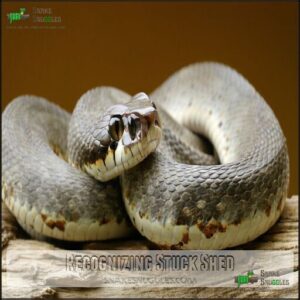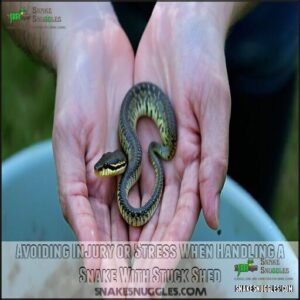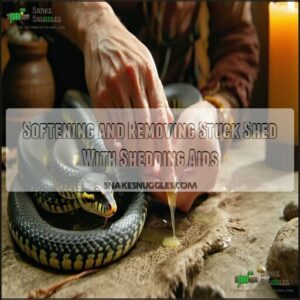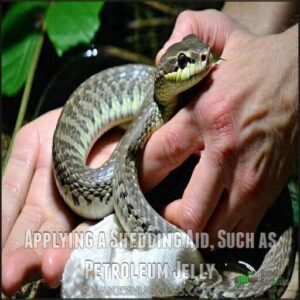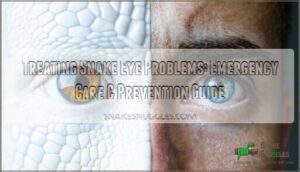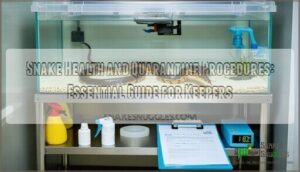This site is supported by our readers. We may earn a commission, at no cost to you, if you purchase through links.
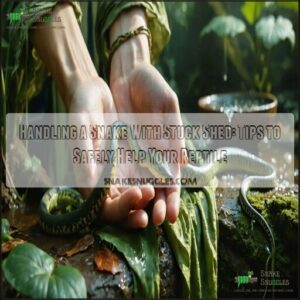 Handling a snake with stuck shed requires patience and precision.
Handling a snake with stuck shed requires patience and precision.
First, boost humidity in its enclosure—think rainforest, not desert.
Soaking your snake in lukewarm, shallow water for 15-20 minutes can work wonders.
For stubborn patches, gently massage the area with a damp cloth or let your snake slither through your hands as you apply light pressure.
Avoid peeling; it’s tempting but risky.
A rough surface like cork bark can help them finish the job themselves.
If the shed’s stuck near the eyes (called eye caps), or persists, consult a reptile vet.
It’s all about balance—help without stressing your slithery friend!
Table Of Contents
- Key Takeaways
- Recognizing Stuck Shed
- Humidity and Hydration
- Safe Handling Techniques
- Removal and Treatment
- Veterinary Care and Precautions
- Frequently Asked Questions (FAQs)
- How to help snakes with stuck shed?
- What to do if a snake gets stuck?
- Why is my snake stuck in a shed?
- Do snakes shed a lot?
- How do you know if a snake has stuck shed?
- Can a stuck shed be over a Snake’s Eyes?
- Can you handle a snake when its about to shed?
- Can you touch a snake shed?
- When should you not handle a snake?
- Conclusion
Key Takeaways
- Boost enclosure humidity and let your snake soak in lukewarm water for 15-30 minutes to soften stuck skin.
- Avoid peeling stuck shed by hand; use a damp cloth to gently massage affected areas or provide rough surfaces like cork bark for natural removal.
- Keep a hygrometer to maintain proper humidity levels and always provide fresh water to prevent future shedding issues.
- If stuck skin, especially around the eyes, doesn’t resolve or shows signs of infection, consult a reptile-savvy vet immediately.
Recognizing Stuck Shed
When your snake has trouble shedding its skin, it’s important to recognize the signs early.
Spotting stuck shed early ensures your snake’s comfort and prevents complications—watch for signs like retained skin, dull eyes, or appetite changes.
Look for symptoms like retained patches of dry skin, dull eyes, or changes in appetite and behavior that may indicate stuck shed.
Signs and Symptoms of Stuck Shed in Snakes
Spotting stuck shed during the snake shedding process is essential.
Keep an eye out for these signs:
- Skin Retention: Look for patches of old skin clinging onto areas like the tail or head.
- Eye Problems: Cloudy, dull eyes might hint at shedding issues.
- Behavioral Changes: Reduced appetite or unusual activity often signals discomfort from snake skin issues.
Proper care prevents scale damage!
Identifying Retained Patches of Skin
When inspecting your snake’s scales, check carefully for retained skin—especially around the tail, eyes, or vent.
Uneven patches or flaky remnants signal shedding difficulties. A thorough snake examination helps monitor scale health and pinpoint shedding issues early.
Addressing even small retained skin patches is essential for a smooth shedding process and to prevent further stuck shed complications or skin irritation.
Noticing Changes in Appetite or Behavior
A stuck shed often disrupts a snake’s normal behavior.
Appetite changes, such as refusing meals, can hint at snake shedding problems.
You might notice lower activity levels or signs of snake stress.
These behavioral signs often signal discomfort, requiring attention.
Addressing these feeding issues promptly guarantees your reptile stays healthy and avoids snake health issues connected to prolonged shedding troubles.
Proper humidity levels, including optimal humidity control, are vital for preventing shedding issues in snakes, which is a key factor in maintaining overall reptile health.
Observing Skin Irritation or Lesions
When handling stuck shed, don’t overlook irritation signs or reptile skin problems.
Redness or sores may signal snake skin problems like skin lesions or scale rot.
Watch for:
- Dry, crusty patches on scales.
- Swollen areas hinting at skin infections.
- Open wounds or snake sores worsening.
- Discoloration near problem spots.
- Repeated scratching or rubbing behaviors.
Prompt lesion care prevents bigger issues!
Humidity and Hydration
Your snake’s shedding process depends on proper humidity and hydration, so keeping these in check is essential.
Providing fresh water, a humidity-adjusted enclosure, and occasional soaking can prevent the skin from sticking and causing discomfort, which is crucial for the snake’s overall health and hydration.
Maintaining Optimal Humidity Levels
Humidity levels are key for snake shedding.
Use a hygrometer for accurate humidity control, aiming for 50-70% based on species.
Boost enclosure humidity by misting or adding damp moss.
Here’s a quick guide:
| Method | Tools Needed | Frequency | Notes |
|---|---|---|---|
| Mist enclosure | Spray bottle | Daily | Cover all corners |
| Add moss | Sphagnum moss | Weekly | Keep damp but not soggy |
| Use water bowls | Shallow dish | Always available | Prevent dehydration |
| Shedding aids | Commercial spray | As needed | Soften retained skin |
Accurate humidity measurement is vital, and using a hygrometer device guarantees proper control.
Proper management guarantees smooth shedding every time, with the help of shedding aids and maintaining the right humidity levels.
Ensuring Proper Hydration Through Access to Fresh Water
A steady, fresh supply of water keeps your snake hydrated and supports healthy shedding.
Follow these hydration tips:
- Use clean water bowls changed daily for good water quality.
- Make certain snake water availability at all times.
Position bowls to avoid spills, and maintain humidity levels with water evaporation.
Watch for your snake drinking to assess its hydration needs.
Providing a Shallow Water Dish for Soaking
A shallow water dish supports snake hydration and skin health, easing stuck shed removal.
Use warm water (not above 85°F) for soaking times of 15–30 minutes.
Clean the dish regularly to maintain water quality.
| Factor | Recommendation | Purpose |
|---|---|---|
| Water Temperature | 80–85°F | Enhances skin hydration |
| Soaking Times | 15–30 minutes | Softens retained skin |
| Dish Cleaning | Weekly or as needed | Maintains snake water availability |
Consistent care improves shedding success.
Maintaining ideal humidity levels is vital for preventing shedding issues, and consistent care is key to improving shedding success with the right water temperature and soaking times.
Safe Handling Techniques
When handling a snake with stuck shed, you need to be gentle and deliberate to avoid stressing or injuring them.
Focus on slow, calm movements and use techniques like soaking or soft massaging to help loosen the retained skin safely.
Avoiding Injury or Stress When Handling a Snake With Stuck Shed
When dealing with your snake’s stuck shed, patience is key.
Rough handling increases stress and risks injury, so stay calm and gentle.
- Support the body: Hold the snake firmly but gently, avoiding pressure on sensitive areas like the spine.
- Reduce stress: Limit handling time and watch for signs of discomfort.
- Wash hands: Make certain hygiene to prevent infections during stuck shed removal.
Gently Massaging The Affected Area With a Damp Cloth
Using a damp cloth is a simple, safe method for handling stuck shed.
Gently massage the affected area in slow, circular motions to avoid stressing your snake. This Damp Cloth Care approach loosens stubborn skin without causing harm.
Think of it as a spa day for your reptile, offering shedding assistance while promoting their comfort.
Proper damp cloth care is essential for effective snake shedding assistance, providing a gentle and safe method.
Soaking The Snake in a Shallow Water Bath
After gently massaging, try soaking your snake in a shallow water bath.
Maintain water temperature between 85-90°F for comfort and proper skin soaking. Limit bath duration to 20-30 minutes to avoid stress.
Snakes benefit from regular warm baths. This encourages relaxation and promotes shedding ease.
Proper snake soaking supports shedding and enhances husbandry, aiding shed removal without injury. Always monitor your snake for signs of distress.
Removal and Treatment
When helping your snake with stuck shed, it’s important to soften the dry skin first by using warm water or shedding aids.
Gently removing the loosened shed with a soft cloth or tweezers will guarantee your snake stays safe and comfortable during the process.
Softening and Removing Stuck Shed With Shedding Aids
Shedding tools, like shedding aids or skin soothers, make stuck shed removal easier by improving moisture levels.
A gentle application of products like petroleum jelly softens stubborn scales, promoting safe shed removal. These methods emphasize scale care while preventing skin damage.
Proper shedding techniques guarantee safety and comfort, helping your snake shed smoothly while supporting peak scale health and stuck shed prevention.
Using the right shedding aids, such as those found through shedding product, can greatly improve the shedding process and aid in stuck shed removal by providing scale care and ensuring safe shed removal.
Using a Soft Cloth or Tweezers to Gently Remove Stuck Shed
After softening the stuck shed, removing it with shedding tools is straightforward.
Use tweezers for precision or a moist cloth for gentle removal. Always support your snake during handling to avoid stress.
When applying cloth techniques, work slowly without forcing the skin. With patience and care, these stuck shed solutions guarantee safe and effective treatment, helping your snake enjoy a smoother shedding process.
Applying a Shedding Aid, Such as Petroleum Jelly
A stuck shed can stubbornly cling, but applying a shedding aid like petroleum jelly helps loosen it effectively.
Here’s how you can do it:
- Spread a pea-sized amount of jelly over the affected area for better hydration.
- Use your fingers or a soft cloth to massage gently.
- Let the snake rest in a humid enclosure to encourage skin release.
Veterinary Care and Precautions
If your snake’s stuck shed doesn’t resolve with proper care, it’s time to consult a reptile-savvy veterinarian.
They can address underlying issues like infections or skin damage while ensuring your snake stays safe and stress-free.
Consulting a Reptile-savvy Veterinarian for Persistent Stuck Shed
If removing stuck shed feels like trying to peel cling wrap off without tearing it, it’s time to call a reptile veterinarian.
Persistent shedding issues may signal deeper reptile health issues. A reptile-savvy expert can provide emergency care, diagnose infections, or even recommend snake surgery if needed.
Trust these specialists for safe solutions suited to your snake’s needs.
Monitoring for Potential Hazards, Such as Infection or Scale Damage
Persistent stuck shed can lead to health issues, so watch for signs of infection or scale damage. Redness, swelling, or discharge are red flags.
Redness, swelling, or discharge? These are danger signs your snake may need urgent care to avoid infection or skin damage.
Frequent health checks keep problems in check while reducing snake stress. Look out for these:
- Scales lifting or missing.
- Unusual odor on the skin.
- Irritated or discolored patches.
- Difficulty breathing from affected areas.
Monitoring for scale rot symptoms is vital in preventing severe complications.
Avoiding Aggressive Removal Methods That Can Cause Skin Tears and Stress
Rough handling can worsen a snake’s stuck shed, leading to skin tears or unnecessary stress.
Always prioritize gentle removal techniques.
Use tools like damp cloths or shedding aids for precise care.
Avoid aggressive scraping or pulling—the skin isn’t a sticker to peel off.
| Action | Effect on Snake | Stress Level | Risk of Injury | Recommended Technique |
|---|---|---|---|---|
| Aggressive scraping | Skin damage | High | Severe | Avoid entirely |
| Moist cloth massage | Safe skin care | Low | Minimal | Recommended |
| Sudden grabbing | Stress increase | High | Moderate | Not advised |
| Warm bath soaking | Hydration support | Low | None | Highly recommended |
| Shedding aid application | Easy skin detachment | Minimal | None | Effectively gentle |
The table outlines the effects of different actions on a snake, highlighting the importance of low stress levels and minimal risk of injury.
It is crucial to choose a recommended technique that supports the snake’s health and well-being.
By following these guidelines, you can ensure a safe and successful shedding process for your snake, promoting its overall hydration support and easy skin detachment.
Frequently Asked Questions (FAQs)
How to help snakes with stuck shed?
Help your snake by soaking it in warm water to loosen the stuck skin.
Gently massage affected areas with a damp cloth. Don’t force removal—this can hurt.
Maintain proper humidity to prevent future issues.
What to do if a snake gets stuck?
If your snake gets stuck somewhere, stay calm and gently free them without pulling hard.
Use a damp towel to slide them loose if needed.
Monitor closely for injuries or stress, and adjust its enclosure setup.
Why is my snake stuck in a shed?
Think of stuck shed as your snake’s way of signaling a moisture problem.
Low humidity, dehydration, poor nutrition, or illness can cause it.
Monitor their environment, providing proper humidity, hydration, and care to prevent issues.
Do snakes shed a lot?
Snakes shed regularly as they grow, with frequency varying by age and species.
Younger snakes shed more often, while adults shed less frequently.
It’s like upgrading a wardrobe—outgrowing the old skin as they mature!
How do you know if a snake has stuck shed?
You’ll notice stuck shed if the snake has dry, flaking patches, dull eyes, or retained skin around their head or tail.
Check for discoloration or irritation—it’s like seeing an unfinished peeling sunburn, which can be a clear sign of stuck shed.
Can a stuck shed be over a Snake’s Eyes?
Nearly 70% of snakes experience stuck shed at some point, and yes, it can cover their eyes, creating "eye caps".
These retained caps can affect vision, so careful removal or professional help is essential.
Can you handle a snake when its about to shed?
You can handle a snake before it sheds, but avoid excessive handling.
Their vision clouds during shedding, making them more defensive.
Keep interactions minimal to reduce stress and make certain their environment supports a smooth shedding process, ensuring a safe and stress-free experience for the snake.
Can you touch a snake shed?
It’s like finding crumpled wrapping paper—yes, you can touch shed snake skin.
Just make certain it’s dry and detached.
Always handle it gently to avoid damage, as snakes’ molts are often delicate and fragile.
When should you not handle a snake?
You shouldn’t handle a snake during shedding, right after it’s eaten, or if it appears stressed or sick.
These times can cause discomfort, digestion issues, or stress, making handling risky for both of you.
Conclusion
Did you know that over 80% of captive snake health issues stem from improper husbandry, including low humidity.
Handling a snake with stuck shed means balancing care and caution. Boost humidity, provide gentle soaks, and let your snake shed naturally with minimal interference.
Avoid peeling stuck skin, and if sections like eye caps remain, seek professional help. By meeting your snake’s hydration and humidity needs, you’ll guarantee a smoother shedding process and a healthier, happier reptile.

